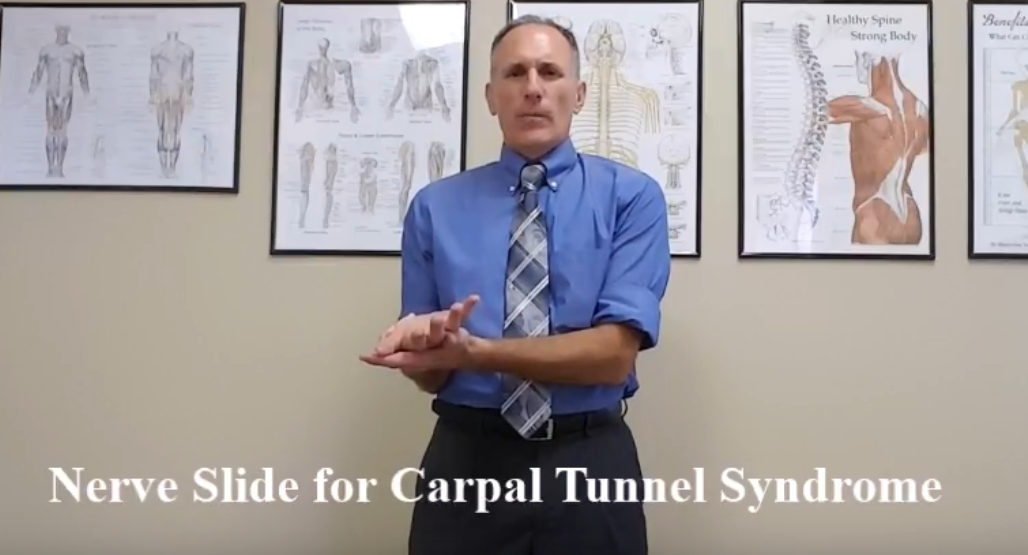Nerve slides are non-exertion, non-resistance motion exercises which help lessen nerve entrapment. Nerve slides are also known as nerve glides and neural mobilization. They are useful in treating nerve entrapment conditions caused by scar tissue encasement.
Nerves are positioned between and through muscles on their path from the spinal cord to their destination in the extremities. Nerves may become impinged along their path and elicit symptoms such as: pain, weakness, fatigue, numbness, tingling, burning, muscle atrophy, heaviness, coldness and swelling.
As nerves run between the muscles, the muscles and nerves normally slide smoothly over each other. When the nerve is impinged, this fluid sliding motion ceases to exist as scar tissue formation begins to encase the nerve to the surrounding tissues at multiple locations.
The gentle sliding motion of nerve slide exercises re-establishes correct motion between the nerves and surrounding muscles by decreasing the scar tissue formation that encases the nerve.
Nerve slide exercises work by moving the limb from a position where the nerve is on it shortest path to a position where the nerve is on its longest path.
Nerve slides may be used for preventive measures, new symptoms, or chronic cases. Instituting nerve slides during short breaks from repetitive motions and static positions at the computer workstation may be effective in preventing nerve entrapment conditions. Implementing nerve slides as self-treatment for newer cases may help lessen symptoms and prevent further damage by lessening the areas and level of scar tissues formation. Utilizing nerve slides in chronic cases may be effective due to the releasing of pressure of multiple areas of nerve encasement.
Nerve slides can be performed every day. Nerve slides should be executed slowly with control and precision through a pain-free range of motion. Start at an appropriate number of repetitions for you and gradually increase until you can perform 5 to 10 repetitions daily of each exercise. Count one complete starting point to finishing point and back to starting point cycle as one repetition. If pain or symptoms are elicited or increased, decrease the number or repetitions or switch to another nerve glide exercise.
Nerve slides exist for a number of conditions including Carpal Tunnel Syndrome (Median Nerve), Cubital Tunnel Syndrome (Ulnar Nerve), Thoracic Outlet Syndrome (Brachial Plexus), Radial Nerve Entrapment, Suprascapular Nerve Entrapment, Spinal Accessory Nerve (CNXI) Entrapment, Quadrilateral Space Syndrome (Axillary Nerve), Piriformis Syndrome (Sciatic Nerve), Tarsal Tunnel Syndrome (Posterior Tibial Nerve) and Common Peroneal Nerve Entrapment.
Nerve slides are motion exercises that can be used to decrease the source and symptoms of nerve entrapment conditions. Restore proper nerve flow by re-establishing fluid motion between the nerves and their surrounding tissues with the use of nerve slide exercises.
Utilize nerve slide movements in conjunction with conservative treatments such as chiropractic care, stretching, massage and yoga. Combine these treatments with proper workstation ergonomics, dynamic motions, frequent microbreaks from static positions and proper nutrition to prevent and lessen scar tissue formation from being the source of nerve impingement.
Here is a list of my videos describing the conditions and demonstrating the nerve slides.
Carpal Tunnel Syndrome – https://youtu.be/j8cCyETIjr8
Carpal Tunnel Syndrome – Nerve Slide for Median Nerve https://www.youtube.com/watch?v=L1_lFjP0uT4
Cubital Tunnel Syndrome (AKA Ulnar Neuropathy at the Elbow) https://youtu.be/sXk2qwlCFoU
Cubital Tunnel – Nerve Slide for Ulnar Nerve https://www.youtube.com/watch?v=L099qjhaneo
Thoracic Outlet Syndrome – https://youtu.be/kEhg-hWfQ8U
Radial Nerve – Nerve Slide https://www.youtube.com/watch?v=gO0fiJne7UU
Suprascapular Nerve Entrapment – https://youtu.be/0I59gqLJ9Ig
Suprascapular Nerve – Nerve Slide https://www.youtube.com/watch?v=YrIAbHYjPR4
Spinal Accessory Nerve (CNXI) Entrapment – https://youtu.be/DhoR7DMVaVc
Spinal Accessory Nerve – Nerve Slide https://www.youtube.com/watch?v=-8fwPGmJ8Mw
Axillary Nerve Entrapment/Quadrilateral Space Syndrome – https://youtu.be/0MKkF-U_y2U
Axillary Nerve – Nerve Slide https://www.youtube.com/watch?v=a-D5qrRKJ-M
Piriformis Syndrome – https://youtu.be/qWhY7sIbsqM
Sciatic Nerve – Nerve Slide – https://www.youtube.com/watch?v=jp0NsWNE-Oo
Common Peroneal Nerve – Nerve Slide https://www.youtube.com/watch?v=VPh2j9XeZx0
Tarsal Tunnel Syndrome – https://youtu.be/ObHUPhB3ELw
Dr Donald A Ozello DC of Championship Chiropractic in Las Vegas, NV
Web Site: http://www.championshipchiropractic.com/
Blog: https://www.championshipchiropractic.com/wordpress/
YouTube: https://www.youtube.com/user/drdozellodc/videos
Twitter: https://twitter.com/drdozellodc
Facebook: https://www.facebook.com/Championship-Chiropractic-280141628688300/
LinkedIn: https://www.linkedin.com/in/dr-donald-a-ozello-dc-716b3233
“Running: Maximize Performance & Minimize Injuries” https://www.amazon.com/Running-Performance-Chiropractors-Minimizing-Potential/dp/1493618741
**Disclaimer: Always consult a medical professional before beginning an exercise program. Always work within your capabilities. Never perform an exercise that elicits or increases pain or symptoms. Reading this article and viewing the linked videos does not take the place of seeing a medical professional. Please visit a medical professional for evaluation, diagnosis & treatment.

